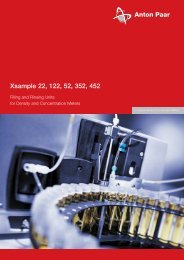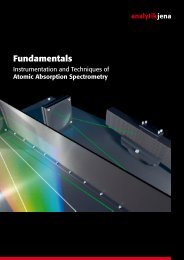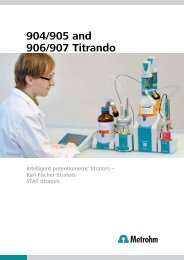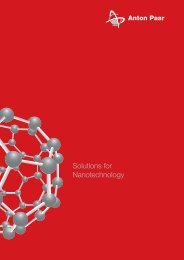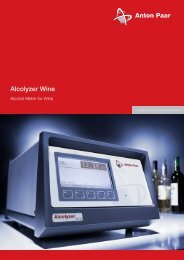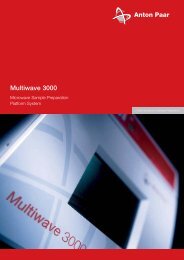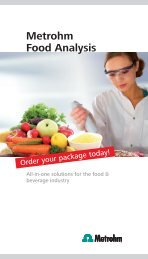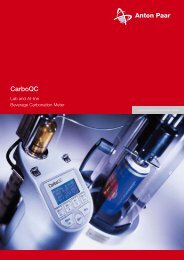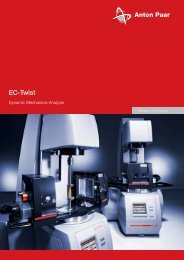Instruments for Measurement of Dissolved ... - MEP Instruments
Instruments for Measurement of Dissolved ... - MEP Instruments
Instruments for Measurement of Dissolved ... - MEP Instruments
You also want an ePaper? Increase the reach of your titles
YUMPU automatically turns print PDFs into web optimized ePapers that Google loves.
<strong>Instruments</strong> <strong>for</strong> <strong>Measurement</strong><br />
<strong>of</strong> <strong>Dissolved</strong> Carbon Dioxide<br />
and Oxygen in Beverages<br />
Lab and At-line<br />
::: Unique Density & Concentration Meters
Wherever You Are:<br />
<strong>Measurement</strong> <strong>of</strong> <strong>Dissolved</strong> CO 2<br />
and O 2<br />
in Beverages<br />
In the production <strong>of</strong> alcoholic and<br />
non-alcoholic beverages, it is essential to<br />
check and control the CO 2<br />
and O 2<br />
content<br />
<strong>of</strong> the product both during the production<br />
process and after bottling.<br />
The CO 2<br />
content strongly influences the<br />
taste <strong>of</strong> beverages and is a considerable<br />
cost factor in beverage production. Precise<br />
measurement <strong>of</strong> the carbon dioxide ensures<br />
consistent taste and cost-efficient dosing.<br />
A high level <strong>of</strong> dissolved O 2<br />
in beverages has<br />
a negative impact on the taste and shelf life<br />
<strong>of</strong> the beverage. The continuous monitoring<br />
<strong>of</strong> the oxygen content ensures product<br />
safety and consistent beverage quality.<br />
The best instrument <strong>for</strong> your application<br />
Whether directly at the production line, in the<br />
laboratory or as part <strong>of</strong> a larger beverage<br />
analyzing system, Anton Paar provides the<br />
best instrument <strong>for</strong> your measurement<br />
application. The range includes instruments<br />
<strong>for</strong> measuring dissolved oxygen and<br />
dissolved carbon dioxide without being<br />
influenced by other dissolved gases such as<br />
air or nitrogen.<br />
CO 2<br />
Air Index<br />
N 2<br />
Index<br />
O 2<br />
Index<br />
CO 2<br />
O 2<br />
Air Index<br />
N 2<br />
Index<br />
At-line<br />
measurement<br />
CarboQC At-line<br />
CboxQC At-line<br />
Have it all: CO 2<br />
and O 2<br />
combined<br />
Anton Paar’s new instrument, CboxQC,<br />
combines the fast measurement <strong>of</strong> CO 2<br />
and<br />
O 2<br />
in one measuring cycle – available <strong>for</strong><br />
portable use at-line as well as in a standalone<br />
version <strong>for</strong> the laboratory.<br />
For the utmost flexibility, the instruments’<br />
new and robust design is small, compact<br />
and lightweight.
Laboratory<br />
measurement<br />
The inventor <strong>of</strong> accurate<br />
CO 2<br />
measurement<br />
System module<br />
integrated in PBA Generation M<br />
measuring systems<br />
method.<br />
measurement.<br />
CarboQC<br />
CarboQC ME<br />
CboxQC CarboQC ME with Option O 2<br />
Anton Paar is the inventor <strong>of</strong> the Multiple<br />
Volume Expansion method, which is the<br />
most accurate way <strong>of</strong> selectively measuring<br />
dissolved CO 2<br />
in beverages. This patented<br />
method provides the most reliable CO 2<br />
results and avoids the shortcomings <strong>of</strong> other<br />
conventional methods <strong>of</strong> CO 2<br />
measurement.<br />
Maximum precision is ensured with the MVE<br />
Measuring dissolved oxygen using a new<br />
optical O 2<br />
sensor via luminescence quenching<br />
creates a new technological dimension <strong>of</strong><br />
World leader in analytical<br />
measuring instruments<br />
Besides years <strong>of</strong> experience in the field<br />
<strong>of</strong> dissolved CO 2<br />
and O 2<br />
determination,<br />
Anton Paar is also the leader in density<br />
and concentration measurement, providing<br />
complete beverage analysis systems <strong>for</strong> the<br />
laboratory and production process.<br />
Close to you<br />
With a global network <strong>of</strong> subsidiaries and<br />
sales partners, Anton Paar is always close to<br />
your site. Local Anton Paar specialists are on<br />
call to give quick and competent after-sales<br />
support, regular maintenance and service.
At-line <strong>Instruments</strong> from the <strong>Measurement</strong> Experts<br />
Direct at-line measurements - whether from<br />
process lines, tanks, kegs or casks - provide the<br />
assurance that your production process is under<br />
control and allow you to verify the CO 2<br />
and O 2<br />
results measured by process equipment.<br />
Fully protected <strong>for</strong> harsh environments<br />
Anton Paar’s at-line series <strong>of</strong> instruments are built to operate<br />
<strong>for</strong> years under rough conditions. The robust and leakpro<strong>of</strong><br />
housings keep humidity out <strong>of</strong> the electronics and stop any<br />
spills entering the instrument.<br />
Quick to finish: saves you time and money<br />
By measuring CO 2<br />
and O 2<br />
in only 90 seconds, Anton<br />
Paar’s CboxQC At-line saves you valuable working time and<br />
there<strong>for</strong>e money.<br />
Portable measurement: 10 hours on the go<br />
CarboQC At-line and CboxQC At-line are portable and<br />
provide a battery life <strong>of</strong> up to ten hours. The battery is<br />
quickly recharged <strong>for</strong> continued operation. For the utmost<br />
flexibility, the instruments’ new design is small, compact and<br />
lightweight.<br />
Low-carbonated beverages? No problem!<br />
With a measuring range from 0 to 20 g/L, Anton Paar’s CO 2<br />
meters not only measure highly carbonated beverages, but<br />
also samples with low CO 2<br />
levels with outstanding accuracy.<br />
Continuous control <strong>of</strong> CO 2<br />
and O 2<br />
?<br />
Data Logger!<br />
Using the CO 2<br />
and O 2<br />
Data Logger function you define<br />
the interval <strong>for</strong> continuous measurements from the line or<br />
tank. With a memory capacity <strong>of</strong> 500 measurement results,<br />
including timestamp and sample ID, Anton Paar’s at-line<br />
instruments are prepared <strong>for</strong> a long working day.
O 2<br />
determination: simple, accurate and ready<br />
<strong>for</strong> measurement anywhere!<br />
The highly accurate determination <strong>of</strong> dissolved oxygen is<br />
based on the optochemical sensor's very fast response<br />
time and ideal temperature behavior. This leads to stable<br />
and precise results in less than 50 seconds. Durability and<br />
minimal maintenance are the prominent features that make<br />
the long-lasting optical sensor stand out.<br />
Easy to use, easy to read<br />
The color display makes sure you see your measuring results<br />
clearly, even in dark surroundings. Due to the intuitive user<br />
interface standard operations can be per<strong>for</strong>med easily. The<br />
eight large keys enable operation <strong>of</strong> the instrument even<br />
when wearing protective gloves.<br />
Get started fast with RFID<br />
Equipped with an RFID interface option, the instruments<br />
enable you to quickly and conveniently change the method<br />
and sample ID automatically, by just reading an RFID tag.<br />
Whether using RFID or manual settings, the instruments<br />
ensure full traceability.<br />
Teams up with process instrumentation<br />
The at-line instruments are the ideal complement to Anton<br />
Paar’s process instrumentation, such as the Carbo 510<br />
online CO 2<br />
analyzer and Cobrix 5 inline beverage analysis<br />
system <strong>for</strong> °Brix, Diet and CO 2<br />
monitoring.
Your Longstanding Partner <strong>for</strong> Laboratory <strong>Measurement</strong>s<br />
Using Anton Paar’s laboratory solutions <strong>for</strong><br />
dissolved gas measurement allows you to<br />
per<strong>for</strong>m reliable QC on finished packages and<br />
run measurements <strong>for</strong> product development<br />
with the highest accuracy.<br />
High accuracy, more benefit<br />
The patented CO 2<br />
measuring method is not influenced by<br />
other dissolved gases such as oxygen and nitrogen, is<br />
rapid, and needs only minimum sample volume.<br />
Together with a new reliable optochemical oxygen sensor<br />
the results achieve the highest level <strong>of</strong> repeatability:<br />
CO 2<br />
repeatability s.d.: up to 0.005 vol.<br />
O 2<br />
repeatability s.d.: ±2 ppb<br />
Low sample amount? No problem!<br />
The very low sample volume <strong>of</strong> around 100 mL provides<br />
reliable CO 2<br />
and O 2<br />
results, even out <strong>of</strong> very small<br />
packages.<br />
PFD filling device - the perfect complement<br />
Using Anton Paar’s CO 2<br />
and O 2<br />
instruments in<br />
combination with a piercing and filling device means easy<br />
handling. Just press 'Start' and the sample is transferred<br />
to the measuring chamber without any loss <strong>of</strong> CO 2<br />
and<br />
O 2<br />
. Reliable results can there<strong>for</strong>e be guaranteed.<br />
TPO quick check? For sure!<br />
Quality control <strong>of</strong> the Total Package Oxygen is in great<br />
demand. By measuring dissolved oxygen the TPO<br />
value can be calculated via Anton Paar’s free s<strong>of</strong>tware<br />
AP-S<strong>of</strong>tPrint or by connecting to a DMA Generation M<br />
system.
Fast and wireless<br />
For fast and simple documentation, Anton Paar’s<br />
dissolved gas meters print your measuring results or<br />
stored data on the optional Bluetooth printer.<br />
Easy checks – reliable results<br />
Anton Paar’s CO 2<br />
and O 2<br />
meters are supplied factoryadjusted<br />
and can be used right from the start. The<br />
periodical recommended system check implemented in<br />
the instruments’ quick access area guides you through<br />
the CO 2<br />
, O 2<br />
and tightness check carried out with<br />
deionized water and nitrogen.<br />
Correct filling <strong>for</strong> correct results<br />
Correct results strongly depend on the right filling under<br />
pressure: the new series’ integrated FillingCheck TM<br />
feature automatically detects filling errors.<br />
Talks the same language<br />
The user interface is clearly arranged and you intuitively<br />
find your way through the menu. Preprogrammed<br />
methods and measuring units, automatic service<br />
reminders and numerous wizard features help you in your<br />
everyday work.<br />
Works through power outages<br />
Voltage fluctuations or power outages are no threat <strong>for</strong><br />
the new series <strong>of</strong> instruments. They automatically switch<br />
to battery-operated mode <strong>for</strong> up to 10 hours. You can<br />
continue your measurements as planned without losing<br />
any data, time or money.<br />
Modular options <strong>for</strong> the future<br />
With the stand-alone instruments you have the option to<br />
connect an Anton Paar DMA Generation M density meter<br />
in the future and there<strong>for</strong>e build your own measuring<br />
system <strong>for</strong> complete beverage analysis such as PBA-B,<br />
PBA-S/SI and PBA-SD.
Built to Work in a Team<br />
Which beverage parameters do you need to<br />
determine? Combine a CarboQC ME module with<br />
a wide range <strong>of</strong> Anton Paar instruments to get<br />
the beverage analysis you need in one measuring<br />
cycle, with minimum sample preparation required.<br />
This teamwork brings quick and efficient results<br />
and saves space in the lab.<br />
Fit <strong>for</strong> the future<br />
Combining a CarboQC ME module with a DMA<br />
Generation M density meter and PFD is a secure<br />
investment which allows you to add further modules in<br />
the future. Whether you require an Alcolyzer, the Option<br />
O 2<br />
, automatic sample changer or other modules at a later<br />
date, Anton Paar's modular concept allows you to create<br />
a measuring system to exactly suit your requirements.<br />
Accuracy that speaks <strong>for</strong> itself<br />
The CarboQC ME provides fast and accurate in<strong>for</strong>mation on<br />
the selective amount <strong>of</strong> CO 2<br />
dissolved in a beverage sample<br />
using Anton Paar’s patented Multiple Volume Expansion<br />
method.<br />
PBA-B PBA-S PBA-SI PBA-SD<br />
O 2<br />
measurement completes the team<br />
Standard configuration<br />
Option O 2<br />
with CarboQC ME allows the simultaneous<br />
determination <strong>of</strong> the dissolved O 2<br />
and dissolved CO 2<br />
contents in beverages within one measuring cycle. The<br />
Option O 2<br />
is the perfect complement <strong>for</strong> Anton Paar’s<br />
beverage analysis systems such as PBA-S/SI/SD and<br />
PBA-B Generation M.<br />
Master instrument DMA M DMA M SDA M/P<br />
DMA M/<br />
SDA M/P<br />
CarboQC ME • • • •<br />
Alcolyzer Beer ME • <br />
A strong partner<br />
Parameters such as density are influenced by dissolved CO 2<br />
.<br />
Knowledge <strong>of</strong> the true CO 2<br />
content can be used to fully<br />
compensate the influence. This means that the density <strong>of</strong> a<br />
carbonated beverage can be fully CO 2<br />
-corrected. No more<br />
degassing required!<br />
DietQC TM ME •<br />
PFD • • • •<br />
Options<br />
pH ME • • • •<br />
Stability <strong>for</strong> years<br />
As the measuring module is permanently connected to the<br />
density meter and does not have to be disconnected or<br />
moved, it has a high level <strong>of</strong> system stability. This gives you<br />
reliable results over a long working life.<br />
Option O 2 • • • •<br />
Options <strong>for</strong> the corresponding system<br />
Color Option <strong>for</strong><br />
Alcolyzer Beer ME<br />
• <br />
HazeQC ME • <br />
Xsample 510<br />
instead <strong>of</strong> PFD<br />
• • •
All results at a glance<br />
The combined system provides the utmost convenience:<br />
The CO 2<br />
and O 2<br />
values are automatically transferred to<br />
the master instrument. Measured data are displayed on<br />
the DMA M density meter screen along with all other<br />
measured parameters. Just press a button to print these<br />
results as one report.<br />
Filling system<br />
PFD<br />
To simultaneously<br />
fill all the<br />
instruments<br />
Sample changer<br />
Xsample 510<br />
For fully automated<br />
operation with up to 18<br />
packages<br />
Alcohol<br />
Alcolyzer Beer ME<br />
To determine the<br />
alcohol content<br />
Beer color<br />
Color Option <strong>for</strong><br />
Alcolyzer Beer ME<br />
To determine the<br />
beer color<br />
Diet<br />
DietQC TM ME<br />
To measure<br />
colored diet s<strong>of</strong>t<br />
drinks<br />
Carbon dioxide<br />
CarboQC ME<br />
To determine the<br />
CO 2 content<br />
Density<br />
DMA 4100/4500/5000 M<br />
To determine the density<br />
S<strong>of</strong>t Drink Analyzer M/P<br />
For the additional<br />
determination <strong>of</strong> °Brix<br />
fresh, °Brix inverted and<br />
degree <strong>of</strong> inversion<br />
Turbidity<br />
HazeQC ME<br />
To determine<br />
the turbidity<br />
Oxygen<br />
Option O 2 <strong>for</strong><br />
CarboQC ME<br />
To determine the<br />
O 2 content<br />
pH<br />
pH ME<br />
To determine<br />
the pH value
Unique:<br />
Multiple Volume Expansion Method<br />
The Multiple Volume Expansion (MVE) method was invented and patented by<br />
Anton Paar (AT 409673, GB 237 3584, US 6,874,351). It determines the true<br />
dissolved CO 2<br />
content in beverages.<br />
How does it work?<br />
The short answer is: MVE is a selective method. By expanding the measuring chamber<br />
twice, only the CO 2<br />
content is determined and the effect <strong>of</strong> other gases - such as nitrogen<br />
and oxygen - is eliminated. In more detail the method works as follows:<br />
1<br />
The measuring chamber<br />
is completely filled with<br />
sample and sealed.<br />
4<br />
The two pressures and<br />
temperatures are used <strong>for</strong> CO 2<br />
determination and dissolved<br />
air compensation.<br />
2<br />
The volume <strong>of</strong> the<br />
measuring chamber is<br />
expanded. Equilibrium is<br />
generated and pressure<br />
and temperature are<br />
measured.<br />
3<br />
The measuring chamber<br />
volume is further expanded,<br />
equilibrium is generated and<br />
pressure and temperature are<br />
measured again.<br />
Why does it work?<br />
The patented Multiple Volume Expansion method makes<br />
use <strong>of</strong> the fact that the solubility <strong>of</strong> air in beverages is<br />
much lower than that <strong>of</strong> CO 2<br />
. Due to the difference in<br />
solubility, when expanding the volume <strong>of</strong> the measuring<br />
chamber, the partial pressure <strong>of</strong> air decreases much<br />
more than that <strong>of</strong> CO 2<br />
. The difference between the<br />
equilibrium pressure and temperature results measured<br />
at the first and second volume expansions <strong>of</strong> the<br />
measuring chamber is used to determine the amount<br />
<strong>of</strong> dissolved air and mathematically calculate and<br />
compensate <strong>for</strong> this amount. The result is the true CO 2<br />
concentration in the beverage.
Why do CO 2<br />
results differ depending on the<br />
measuring method used?<br />
The answer lies in the way the measurement<br />
is influenced by the following factors:<br />
CO 2<br />
≠ CO 2<br />
4 External environmental influences<br />
- Altitude & weather<br />
4 Method-dependent influences<br />
- Snifting<br />
- Compensation tables<br />
- Incomplete equilibration<br />
4 Sample-dependent influences<br />
- <strong>Dissolved</strong> air in the sample<br />
- Package size<br />
Altitude & weather<br />
Environmental factors affect CO 2<br />
measuring instruments.<br />
Anton Paar’s CO 2<br />
meters have an integrated absolute<br />
pressure sensor <strong>for</strong> accurate correction.<br />
Incomplete equilibration<br />
Incomplete equilibration causes the CO 2<br />
measurement<br />
to deliver results which are different than the actual CO 2<br />
content.<br />
Snifting<br />
Snifting is generally per<strong>for</strong>med with traditional pressure/<br />
temperature (p/T) methods <strong>for</strong> compensating dissolved air<br />
when measuring CO 2<br />
in bottles or cans. Snifting means<br />
briefly opening and closing the package in order to release<br />
the overpressure in the headspace to the ambient pressure.<br />
During snifting, some carbon dioxide is also lost from the<br />
beverage which leads to falsified results. To eliminate the<br />
influence <strong>of</strong> snifting, Anton Paar's CO 2<br />
meters use the<br />
Multiple Volume Expansion method, which delivers CO 2<br />
results which are not affected by the air or nitrogen content.<br />
Compensation tables<br />
Tables are used to compensate the effects <strong>of</strong> snifting.<br />
However, as snifting is affected by many external factors, it<br />
is impossible to know whether the tables are compensating<br />
too much, not enough or correctly <strong>for</strong> the snifting effects.<br />
<strong>Dissolved</strong> air in the sample<br />
Traditional pressure/temperature (p/T) methods do not<br />
differentiate between the partial pressure <strong>of</strong> air and the<br />
partial pressure <strong>of</strong> CO 2<br />
measured in the beverage. Pressure<br />
measurement is assumed to be a one-to-one measure <strong>of</strong><br />
carbon dioxide alone, which is incorrect. This effect is also<br />
seen when using instruments which apply single expansion<br />
<strong>of</strong> the measuring chamber.<br />
Package size<br />
Traditional p/T methods determine the CO 2<br />
content indirectly<br />
by measuring temperature and pressure right out <strong>of</strong> the gas<br />
phase in the headspace. Depending on the type <strong>of</strong> package,<br />
the headspace sizes vary, which affects the amount <strong>of</strong> CO 2<br />
measured. Anton Paar’s CO 2<br />
meters directly determine the<br />
CO 2<br />
content out <strong>of</strong> the liquid phase.
Precise:<br />
O 2<br />
Measuring Method<br />
The continuous monitoring <strong>of</strong> the oxygen content with an instrument that<br />
remains unaffected by other dissolved gases is indispensable <strong>for</strong> beverage<br />
analysis. Anton Paar presents a new dimension <strong>of</strong> measuring dissolved<br />
oxygen in beverages.<br />
Luminescence process in the absence <strong>of</strong> oxygen<br />
Excited state<br />
Absorption <strong>of</strong> light<br />
Emission <strong>of</strong> light<br />
In the presence <strong>of</strong> oxygen: the quenching process<br />
Excited state<br />
How does it work?<br />
Anton Paar’s oxygen meter uses an optochemical sensor<br />
<strong>for</strong> fast and highly accurate determination <strong>of</strong> dissolved<br />
oxygen. The principle <strong>of</strong> measurement is based on the<br />
effect <strong>of</strong> dynamic luminescence quenching by molecular<br />
oxygen. The new way <strong>of</strong> measurement in this sensor allows<br />
measuring while liquids are flowing through the cell. It is not<br />
a stationary measurement.<br />
O 2<br />
O 2<br />
Absorption <strong>of</strong> light<br />
No emission <strong>of</strong> light<br />
Energy transfer by collision<br />
Measuring principle <strong>of</strong> dissolved oxygen<br />
What makes Anton Paar’s measurement <strong>of</strong><br />
oxygen unique?<br />
The pressure-resistant, high-resolution optical oxygen sensor<br />
correctly measures all kinds <strong>of</strong> beverages. The fast response<br />
time and ideal temperature behavior <strong>of</strong> the sensor allow<br />
excellent measurement stability within a few seconds, even<br />
when measuring cold samples.<br />
This means the measuring principle guarantees results<br />
based on the repeatability <strong>of</strong> ± 2ppb and reproducibility <strong>of</strong><br />
± 4ppb as well as multiple measurements even out <strong>of</strong> small<br />
sample packages. The sensor has a long working life and<br />
requires minimal maintenance.<br />
The sensor characteristic shows a response time <strong>of</strong> less than<br />
20 seconds when changing from water to beer at 4 °C to 7 °C.<br />
<strong>Measurement</strong> conditions:<br />
Sample package: 0.5 L beer can<br />
Temperature: 6 °C to 11 °C<br />
Rinsing volume be<strong>for</strong>e starting measurement: 240 mL<br />
Rinsing volume between each measurement: 50 mL<br />
Oxygen determination – simple, accurate and ready <strong>for</strong> measurement anywhere!
Automatic Filling <strong>of</strong> up to 18 Samples<br />
Filling CarboQC and CboxQC<br />
in the laboratory<br />
PFD Piercing and Filling Device<br />
Fill samples reliably and safely directly out <strong>of</strong> PET bottles, glass<br />
bottles or cans into the measuring chamber using the PFD. No<br />
sample preparation, such as degassing or filtering, is needed.<br />
PFD pierces the bottle closure or the base <strong>of</strong> the can and<br />
transfers sample from the package using a compressed gas.<br />
No dissolved CO 2<br />
or O 2<br />
is lost.<br />
4 gas spring <strong>for</strong> safety shield ensures operator safety<br />
4 easy cleaning due to removable safety shield<br />
4 stability guaranteed by clever design and high-quality<br />
materials<br />
SFD Sparkling Wine Filling Device<br />
For transferring wine and sparkling wine samples, the SFD<br />
filling device is available. SFD pierces the cork <strong>of</strong> the wine<br />
bottle and inserts a sample tube. The sample is transferred<br />
under pressure without loss <strong>of</strong> CO 2<br />
. The SFD Filling Device<br />
can be used with both plastic and traditional corks.<br />
4 full operator protection<br />
4 <strong>for</strong> all sizes, from small bottles to magnum bottles<br />
4 sample transfer directly from the bottle<br />
Filling CarboQC ME and CarboQC ME +<br />
Option O 2<br />
in a modular system<br />
To fill a modular system including a CarboQC ME (e.g. Anton<br />
Paar’s PBA systems), you can connect a PFD or SFD <strong>for</strong><br />
single samples or use an Xsample 510 package sampler.<br />
Xsample 510 Package Sampler<br />
The Xsample 510 fills samples from up to 18 different<br />
types <strong>of</strong> bottles or cans fully automatically and cleans the<br />
measuring cells between measurements.<br />
4 high sample throughput – optional bar code reader<br />
4 fully automatic filling and cleaning<br />
4 easy handling - high safety standard - robust design
Specifications<br />
Measuring range<br />
CO 2<br />
CarboQC At-line<br />
0 g/L to 12 g/L (0 vol. to 6 vol.) at 30 °C (86 °F)<br />
0 g/L to 20 g/L (0 vol. to 10 vol.) < 15 °C (59 °F)<br />
CboxQC TM At-line<br />
O 2 -- 0 ppm to 4 ppm<br />
Temperature<br />
Pressure<br />
Repeatability s.d. CO 2 0.04 g/L (0.02 vol.)<br />
O 2 -- ± 2 ppb 1<br />
Pressure<br />
0.01 bar<br />
Reproducibility s.d. CO 2 0.1 g/L (0.05 vol.)<br />
O 2 -- ± 4 ppb 2 , ± 10 ppb 3 , ± 20 ppb 4<br />
Pressure<br />
0.08 bar<br />
Resolution CO 2 0.01 g/L<br />
O 2 response time t 98 %<br />
Measuring units<br />
O 2 -- 0.1 ppb < 100 ppb<br />
--<br />
CO 2 : g/L, vol., kg/m 3<br />
Temperature: °C, °F, K<br />
Air/O 2 /N 2 Index: ppm, mg/L<br />
Package pressure: bar, psi, mbar, kPa<br />
less than 20 seconds at 25 °C,<br />
from air to nitrogen<br />
CO 2 : g/L, vol., kg/m 3<br />
O 2 : mg/L, ppm, ppb, % sat., µg/L<br />
Temperature: °C, °F, K<br />
Air/N 2 Index: ppm, mg/L<br />
Package pressure: bar, psi, mbar, kPa<br />
Sample volume 150 mL 150 mL<br />
Measuring time per sample 55 seconds 90 seconds<br />
0 bar to 10 bar absolute (0 psi to 145 psi)<br />
CO 2 :<br />
Temp<br />
Air/O 2 /N<br />
Package pres<br />
Power supply AC 100-240 V, 50/60 Hz, 1.5 A; DC 12 V, 3.0<br />
Rechargeable battery type Li-Ion 11.1 V, 2.25 Ah (optional: Li-Ion 11.25 V, 2<br />
Maximum at-line operation<br />
Interfaces<br />
Data memory<br />
Options<br />
1 x USB <strong>for</strong> PC, 1x RS-232 <strong>for</strong> printer/AP-S<strong>of</strong>tPrint<br />
optional: 1 x RFID, 1 x Bluetooth<br />
High-per<strong>for</strong>mance battery, RFID/Bluetooth option<br />
up to 10 hours<br />
500 measured results<br />
Available accessories Portable thermal printer with Bluetooth interface, RFID tags, carrying strap Portable therm<br />
At-line<br />
1 x<br />
High<br />
Protection class<br />
Dimensions (L x W x H)<br />
262 mm x 209 mm x 176 mm (10.3 in x 8.2 in x 6.9 in)<br />
IP67<br />
Weight 2.1 kg (4.6 lbs) 2.7 kg (6 lbs) 2.<br />
1 Valid <strong>for</strong> measuring range < 200 ppb<br />
2 Valid <strong>for</strong> measuring range < 1000 ppb<br />
3 Valid <strong>for</strong> measuring range < 1000 to 2000 ppb<br />
4 Valid <strong>for</strong> measuring range < 2000 to 4000 ppb<br />
PFD<br />
piercing and filling device<br />
Sample filling<br />
SFD<br />
piercing and filling device <strong>for</strong> sparkling wine and wine<br />
bottles<br />
Filling mode Pressurized filling from closed packages Pressurized filling from closed and open packages<br />
Compressed gas supply<br />
Package types and maximum allowed volume<br />
<strong>of</strong> packages to be measured<br />
Maximum height with piercing<br />
head in highest position<br />
6 ± 0.5 bar (87 ± 7 psi) relative<br />
Glass bottles: 1 L<br />
Cans: 0.5 L<br />
PET bottles: 3 L<br />
Ambient temperature <strong>for</strong> operation 0 °C to +40 °C<br />
(+32 °F to +104 °F)<br />
Dimensions (L x W x H)<br />
7.5 bar relative ±0.5 bar<br />
(109 psi ±7 psi) <strong>for</strong> sparkling wine<br />
3 bar relative ± 0.5 bar (44 ± 7 psi) <strong>for</strong> wine<br />
Glass bottles: 0.2 L to 1.5 L<br />
1020 mm (40.2 in) 690 mm (27.2 in)<br />
190 mm x 270 mm x 670 mm<br />
(7.5 in x 10.6 in x 26.4 in)<br />
0 °C to +40 °C<br />
(+32 °F to +104 °F)<br />
320 mm x 370 mm x 550 mm<br />
(12.6 in x 14.6 in x 21.7 in)<br />
Weight 10.1 kg (22.3 lbs) 12.3 kg (27.1 lbs)<br />
Power supply -- --<br />
Interfaces -- --<br />
5 Depending on the diameter <strong>of</strong> the package
Laboratory<br />
System<br />
CarboQC CboxQC TM CarboQC ME CarboQC ME + Option O2<br />
0 g/L to 12 g/L (0 vol. to 6 vol.) at 30 °C (86 °F)<br />
0 g/L to 20 g/L (0 vol. to 10 vol.) < 15 °C (59 °F)<br />
0 g/L to 12 g/L (0 vol. to 6 vol.) at 30 °C (86 °F)<br />
0 g/L to 20 g/L (0 vol. to 10 vol.) < 15 °C (59 °F)<br />
-- 0 ppm to 4 ppm -- 0 ppm to 10 ppm<br />
-3 °C to 30 °C (27 °F to 86 °F), acc. ± 0.2 °C<br />
0 bar to 6 bar relative (0 psi to 87 psi)<br />
0.01 g/L (0.005 vol.) 0.01 g/L (0.005 vol.)<br />
-- ± 2 ppb 1 -- 5 ppb 1<br />
0.005 bar -- --<br />
0.05 g/L (0.025 vol.) 0.05 g/L (0.025 vol.)<br />
-- ± 4 ppb 2 , ± 10 ppb 3 , ± 20 ppb 4 -- 20 ppb 2<br />
0.04 bar -- --<br />
0.001 g/L -- --<br />
-- 0.1 ppb < 100 ppb -- --<br />
--<br />
g/L, vol., kg/m 3<br />
erature: °C, °F, K<br />
2 Index: ppm, mg/L<br />
sure: bar, psi, mbar, kPa<br />
less than 20 seconds at 25 °C,<br />
from air to nitrogen<br />
CO 2 : g/L, vol., kg/m 3<br />
O 2 : mg/L, ppm, ppb, % sat., µg/L<br />
Temperature: °C, °F, K<br />
Air/N 2 Index: ppm, mg/L<br />
Package pressure: bar, psi, mbar, kPa<br />
--<br />
CO 2 : g/L, vol., kg/m 3<br />
Temperature: °C, °F, K<br />
Air/O 2 /N 2 Index: ppm, mg/L<br />
Package pressure: bar, psi, mbar, kPa<br />
less than 20 seconds at 25 °C,<br />
from air to nitrogen<br />
CO 2 : g/L, vol., kg/m 3<br />
O 2 : mg/L, ppm, ppb, % sat., µg/L<br />
Temperature: °C, °F, K<br />
Air/N 2 Index: ppm, mg/L<br />
Package pressure: bar, psi, mbar, kPa<br />
100 mL 100 mL approx. 150 mL min. 150 mL (when filling similar samples)<br />
55 seconds 90 seconds approx. 90 seconds approx. 2 minutes<br />
A -- --<br />
.6 Ah) -- --<br />
USB <strong>for</strong> PC, 1 x RS-232 <strong>for</strong> printer/AP-S<strong>of</strong>tPrint/DMA Generation M<br />
optional: 1 x RFID, 1 x Bluetooth<br />
-per<strong>for</strong>mance battery, PFD, SFD, Xsample 510, RFID/Bluetooth option<br />
-- --<br />
2 x CAN 2 x CAN<br />
1000 measured results<br />
Module with DMA M or S<strong>of</strong>t Drink Analyzer M/P as a master instrument;<br />
pH ME, DietQC ME, HazeQC ME, Alcolyzer Beer ME + Color Option, PFD, Xsample 510<br />
al printer with Bluetooth interface, RFID tags, carrying strap, rubber protection -- --<br />
258 mm x 201 mm x 170 mm (10.2 in x 7.9 in x 6.7 in)<br />
-- --<br />
305 mm x 85 mm x 275 mm<br />
(12.0 in x 3.3 in x 10.8 in)<br />
320 mm x 120 mm x 330 mm<br />
(12.6 in x 4.7 in x 13.0 in)<br />
0 kg (4.4 lbs) 2.6 kg (5.7 lbs) approx. 3.0 kg (6.6 lbs) approx. 3.7 kg (8.2 lbs)<br />
Xsample 510<br />
automatic package sampler<br />
Automatic pressurized filling from up to 18 5 closed packages<br />
6 bar (87 psi) relative<br />
Glass bottles: 0.33 L, 0.5 L<br />
Cans: 0.25 L, 0.33 L, 0.5 L<br />
PET bottles: 0.5 L, 1 L, 1.5 L, 2 L, 3 L<br />
--<br />
0 °C to +35 °C<br />
(+32 °F to +95 °F)<br />
900 mm x 750 mm x 1200 mm<br />
(35.4 in x 29.5 in x 47.2 in)<br />
75 kg (165.3 lbs)<br />
AC 100-240 V, 50/60 Hz<br />
1 x RS-232, 1 x S-BUS , 1 x CANopen in, 1 x CANopen out
Photos: Croce & Wir<br />
Specifications<br />
subject to change<br />
without notice.<br />
01/13 D35IP001EN-A


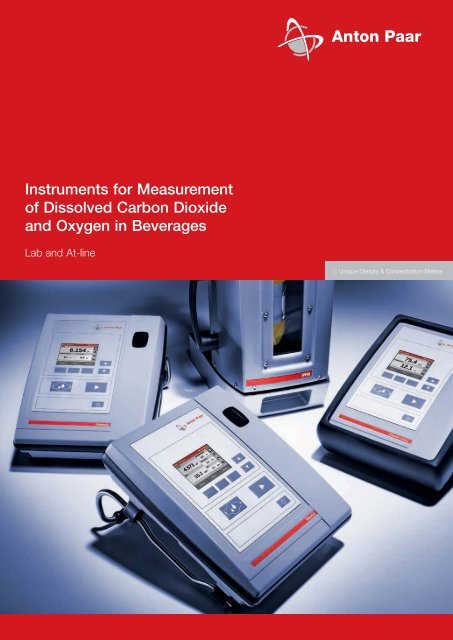
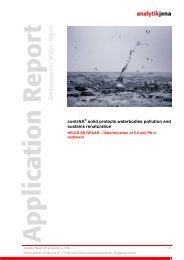
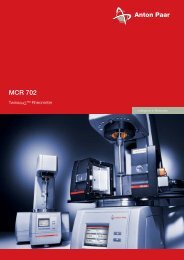
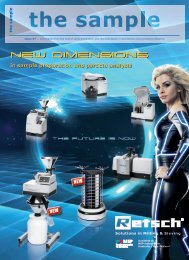
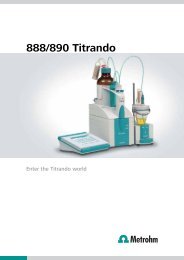
![Rice, size measurement of broken grains [pdf] - MEP Instruments](https://img.yumpu.com/46724497/1/184x260/rice-size-measurement-of-broken-grains-pdf-mep-instruments.jpg?quality=85)
